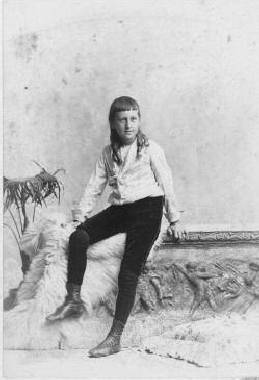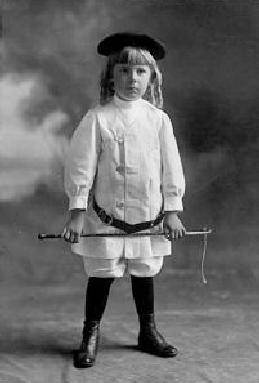17th Century
18th Century
Boys in the 18th century tended to have have long hair, but it was commonly drawn back in a pony tail. This gave appearance of short hair when the boy's hair was actually long. Wigs were common, but not for boys, except for the very rich. Wigs disappeared Boys at the end of the 18th century as a consequence of the French Revolution.
|
19th Century
We see quite a range of syles during the 19th century. Boys hair styles in the early 19th century tended to short. We no longer see wigs or pony tails.
Our information is limited, but we note short hair in available painted portraits. In paintings or illustrations we do not see boys with long hair, except for very young boys who mught noy have their curls cut.
We know much more about the mid-19th century because of the development of photography. Short hair continued to be popular, but many boys had longer cuts. We see few boys with really long hair down to their shoulders, but boys often wore their hair over the ears. A good example is an nglish boy, John Denton, in 1858. We seen shorter cuts in the 1860s and by the end of the decsade boys rarely had hair ver their ears. Gradually shorter cuts became increasingly popular in the late 19th century. Younger boys from affluent families might have long hair, even ringlet curls. Mrs Burnett's book, Little Lord Fauntleroy was published in 1885 and helped increase the popularity of long hair for boys. We note a lot of similarity in Europe and America during the 19th century. A major departure was the ringlet curls worn by American boys. This was much less common in Europe. Bots might have long hair, but they were less commonly done in ringlets. The styles of long hair varied from country to country. Long hair was not common in Germany and Russia. It was popular in France, but rarely curled. Many American boys with long hair had it done in ringlets. The styles in England were more varied. The French even called ringlets "English curls". Actually yjey were much more common in America. A good example of an English boy with long uncurled hair is Carl Roos in 1881.
|
20th Century
The standard for boys hair by the 20th century had become short cuts. This was the case through most of the century with some notable exceptions. Boys' hair styles in the early 20th century were often quite short. German and many other European boys often had very close-cropped hair. This was much less common in Britain and America.We still see some boys wearing long hair in the very early 20th century. The trend was, however, short hair. American and English boys generaly had hair long enough to comb. German boys often had very short cropped hair. After World war I, cropped hair became less common, but short hair was standard. Only younger pre-school boys had longer styles and even these boys usually did not have hair at lengths much over the ears. After World War II, hair styles in America became very short. In the 1950s some teenagers had long side burns, but this was usually boys who wanted to demonstrate a rebelious attitude. No school age boys wore long hair. The short cuts by crew cuts were especually popular in America. Not all boys had them, but they were seen as very styish. We do not see theseshort cuts as a major style in Europe. Until the 1970s you almost never saw school-age boys with long hair. Generally long hair even curls has in the 19th and even the 20th century been seen as appropriate for younger, pre-school boys. Long hair came back into style in the 1970s. Often this mean hair over the ears, but shoulder-length styles were not uncommon. By the 1990s shorter styles became more popular, including cropped hair.
21st Century
Shorter styles have become popular in the erly 21st century, but there seems to be a high degree of toleration for boys who care to wear longer styles. Parental tastes are often less important than in earlier eras. An American reader writes in 2007, "In California, we are now seeing everything from very short hair to the long "Hippie" look of the 60's. In the elementary ages, shorter hair is more common. At the Middle School level, you see more boys with longer hair, usually un-styled and "messy" looking, bur rarely shoulder-length. The shoulder length hair is usually more prevalent in High School. Out of 10 boys, I would say that 3 or 4 will now have longer hair, but it's still nothing like it was in the 70's when short-haired boys were in the vast minority."
HBC
Navigate the Boys' Historical Clothing hair style pages:
[Return to the Main long hair chronology page]
[Return to the Main long hair page]
[Return to the Main hair page]
[Bangs]
[Sausage curls]
[Shoulder-length hair]
[Hair bows]
[Hats and caps]
[Collar bows]
Navigate the Boys' Historical Clothing Web Site:
[Introduction]
[Activities]
[Biographies]
[Chronology]
[Cloth and textiles]
[Clothing styles]
[Countries]
[Topics]
[Bibliographies]
[Contributions]
[FAQs]
[Glossaries]
[Images]
[Links]
[Registration]
[Tools]
[Boys' Clothing Home]
Created: 11:31 PM 5/27/2007
Last edited: 5:05 AM 9/8/2011



